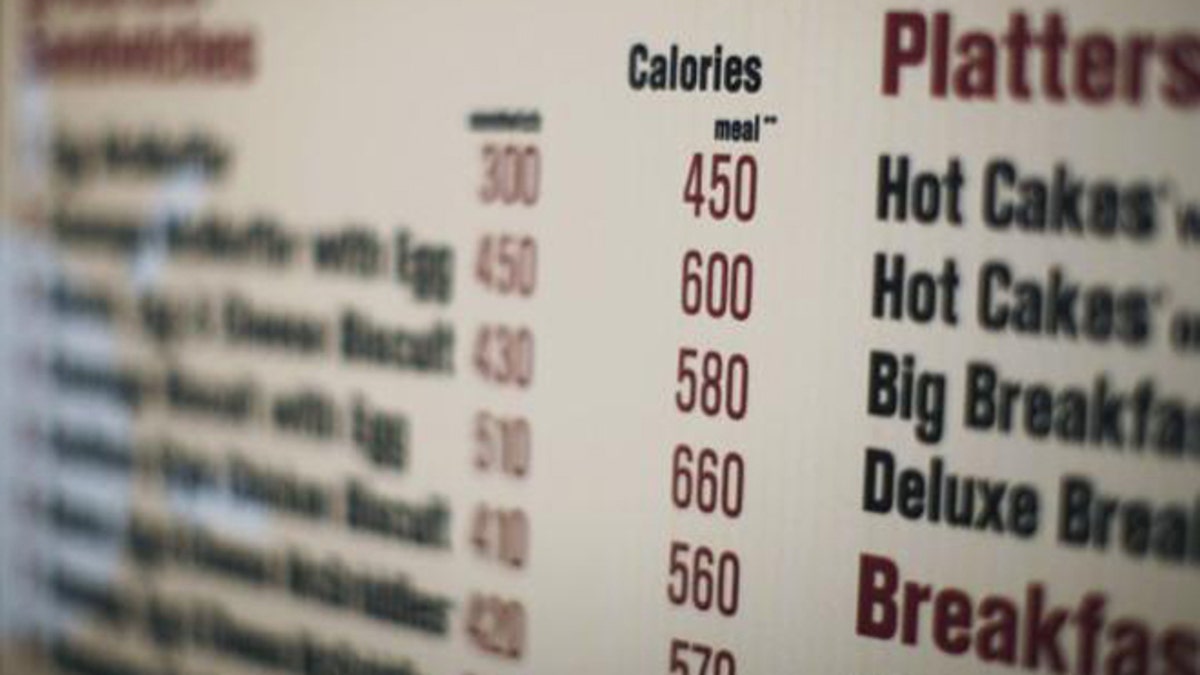
(AP)
Here’s food for thought! Despite the looming “fiscal cliff,” a national debt standing at $16 trillion and counting, and high unemployment rates, our federal government continues to create heavy-handed, and often times unnecessary, regulations for our small businesses -- the true engines of the nation’s economic growth. A case in point is a pending federal regulation dealing not with America’s many pressing financial needs, but the calorie count of food at your local restaurant.
Tucked into the Patient Protection and Affordable Care Act (aka ObamaCare) is Section 4205, a provision requiring restaurants with 20 or more locations to post in-store menu boards with the calorie information for every possible menu order. At first glance, this seems like a reasonable request. After all, who is against helping consumers make wise nutritional choices?
However, as we have seen before with the “food police” and their unending appetite for regulations, the best intentions often go astray. This regulation by the FDA is a prime example of regulators run amok.
Consider the specifics. For restaurants that provide customers with customizable meal options, there can be literally millions of possible order combinations. For example, Domino’s Pizza has calculated that there are 34 million ways to order one of its pizzas (yes, you read correctly; they’ve done the calculations). To account for this, the bureaucrats suggest that restaurants list calorie ranges for customized food. But this can result in huge ranges -- up to 2,000 calories wide in some cases. How does that help consumers?
[pullquote]
On top of that, the rules call for large orders, clearly intended for a family, to be labeled as a single item. Calories would be listed for the whole order instead of clearly defined servings. So if a family of three splits a big salad or a platter of lasagna, they had better bring a calculator to help with the fractions.
The rules also ignore specialized business models and the fact that numerous establishments operate very differently from the standard, dine-in restaurant. Think of your average pizza delivery company, which receives the vast majority of orders over the phone and online. The federal government would require these stores to maintain expensive in-store menu boards even though up to 90 percent of their customers never set foot inside the store and never would see the menu boards. Additionally, many of these same restaurants already provide their customers with calorie information either online or in other easily accessible forms.
According to the proposed regulations issued by the Obama administration, the provision also would be extended to your local grocery store, even though 95 percent of their products are already labeled with nutrition information.
Yet in the case of grocery stores and supermarkets, no state or city (including New York City) has lumped grocery stores into these menu labeling laws. In fact, when Congress considered menu labeling, grocery stores were held up as a model for the rest of the food industry for all of the nutritional information they provide.
Basic common sense aside, the impact of complying with this regulation spells financial disaster for these businesses. According to the Food Marketing Institute (FMI), this regulation could cost the supermarket industry, which is currently operating at one-percent margins, more than $1 billion in compliance costs in the first year, with ongoing costs resulting in hundreds of millions of dollars annually.
And for the restaurants forced to comply with the absurd requirements, keep in mind that many of the facilities are actually operated by small, independent business owners who often operate just one location.
In fact, the White House Office of Management and Budget (OMB) found this regulation would amount to one of the largest regulatory burdens of any law under implementation—resulting in more than 14 million compliance hours.
The good news is that there is bipartisan legislation in the House and Senate to address this issue. The Common Sense Nutrition Disclosure Act of 2012 (H.R. 6174 and S.3574) ensures that grocery and convenience stores which already provide nutritional information on a high majority of their food items are not roped into a new set of regulatory burdens. And it permits restaurants to provide nutritional information in a way that makes sense for each individual operation. The bill also provides restaurants protection from frivolous class action lawsuits if the hand-made food does not match the exact specs every time. In other words, the legislation would replace a one-size-fits-all directive with an approach that actually empowers restaurant consumers without breaking the bank.
The FDA is expected to issue a final ruling on this regulation by the end of the year, and has thus far turned a deaf ear to the concerns of the pizza and grocery industry.
The 2012 election was supposed to signal a new bipartisan spirit in Washington to help tackle our country’s most important issues—which include keeping America open for business. Congress can signal that course by passing this legislation.
